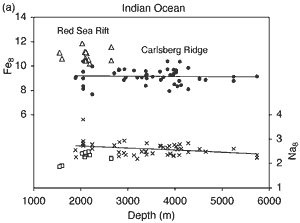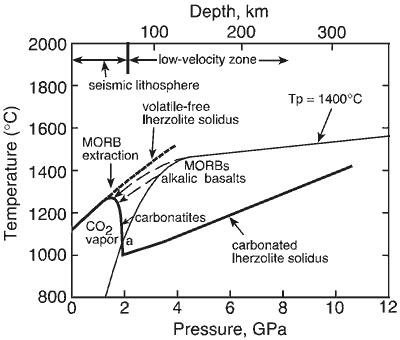 |
No
Plumes Along Mid-Ocean Ridges |
Dean
C. Presnall
Department of Geosciences, University of Texas
at Dallas, Texas, USA
Bayerisches
Geoinstitut, Universität
Bayreuth, Germany
Geophysical Laboratory, Washington,
D. C., USA
dpresnall@ciw.edu
 Click here to
download a PDF version of this webpage Click here to
download a PDF version of this webpage
Hot plumes were considered by Morgan (1971,
1972) to be basic components of a whole-mantle thermal
convection regime that guides and helps maintain volcanism
along spreading ridges. These plumes have been considered
to be the main or even total (Yamamoto et
al.,
2007) source of thermal energy that drives plates. They
would also provide the energy for enhanced lava production
and locally higher temperatures along spreading ridge. A
recent paper (Presnall & Gudfinnsson,
2007) presents a new model for the generation of mid-ocean
ridge basalts (MORBs) and oceanic lithosphere formation. This
model addresses the temperatures of melt extraction
along mid-ocean ridges, an approach toward mapping
of mantle heterogeneity beneath ridges, and the existence
of hot plumes at volcanic centers (e.g., Jan Mayen,
Iceland, Azores, St. Helena, Tristan, Bouvet, Afar,
Easter) on or close to ridges.
An earlier model (Klein
& Langmuir,
1987; 1989; Langmuir et al., 1992;
hereafter LKP), involves a range of short (cool) to
long (hot) melting columns, with aggregate melts produced
at the surface that combine melt increments from the
entire depth range of a column. They
introduced the parameters Na8 and Fe8 (Na2O
and FeO normalized to MgO = 8%), in order to remove
the variations of Na2O and FeO caused by
low-pressure fractional crystallization and to reveal
the chemical systematics produced by melting. To
explain variations of Na8 and Fe8 vs. axial
ridge depth, LKP claimed that long melting columns
that start at high T and P produce melts that are high
in Fe8, low in Na8, and characteristic of shallow ridges
with a thick crust. In contrast, they proposed that
short melting columns that start at low T and P produce
melts that are low in Fe8, high in Na8, and characteristic
of deep ridges with a thin crust. These were
called the global trends and were considered to be
characteristic of ridge lengths of hundreds to thousands
of km.
In a global reevaluation of the LKP
modeling, Presnall & Gudfinnsson (2007)
confirmed that when Na8 and Fe8 are plotted against
each other, rough positive and inverse trends occur,
as reported by LKP. However,
no ridge segments with “global” lengths
were found that support an increase of Na8 and decrease
of Fe8 with increasing axial ridge depth. This
absence of this key correlation requires a different
kind of modeling. In the system CaO-MgO-Al2O3-SiO2-Na2O-FeO
(CMASNF), solidus melt compositions in the plagioclase/spinel
lherzolite transition (~0.9-1.5 GPa) show an inverse
correlation of Na2O vs. FeO at
constant MgO (Presnall et al., 2002; Presnall
& Gudfinnsson, 2007). This matches the
global Na8-Fe8 correlation of LKP but occurs for solidus
melts over a very narrow P-T range of ~1.2-1.5
GPa and ~1250-1280°C.
Also,
if MgO is relatively uniform but allowed to vary slightly,
Na2O varies positively with FeO during progressive
fractional melting of ascending mantle source material
(Presnall & Gudfinnsson, 2007). In
this modeling, the inverse variation of Na8 vs. Fe8 is caused by mantle heterogeneity rather than temperature
variations. The
positive correlation is produced by fractional melting
over a narrow pressure range. For example, Figure
1a shows, for the Carlsberg Ridge, a ridge of “global” length
sampled over a distance of ~5,300 km, that neither
Na8 nor Fe8 correlate with ridge depth. Thus, the LKP
modeling fails. However, the combined Red Sea
and Carlsberg data show an inverse correlation in which
the Red Sea data are consistently displaced to higher
Fe8 and lower Na8 values than the Carlsberg Ridge values
(Figure 1b). This is consistent with mantle heterogeneity
in which the Red Sea mantle is enriched in FeO/MgO
and depleted in Na2O relative to the mantle
beneath the Carlsberg Ridge. Melt extraction
over a large and varying P-T range from a chemically
homogeneous mantle is replaced by melt extraction at
relatively constant P-T conditions from a heterogeneous
mantle.
 
Figure 1. Na8-Fe8-depth data
for Red Sea Rift and Carlsberg Ridge (from Presnall
&
Gudfinnsson, 2007).
Presnall & Gudfinnsson (2007)
proposed that the very narrow range of P-T conditions
for MORB extraction is imposed by the maximum temperature
for explosive escape of CO2 from the mantle. This
maximum temperature is caused by the abrupt temperature
drop of the solidus curve for carbonated lherzolite
(Wyllie & Huang, 1975; Eggler,
1976; Falloon
& Green, 1989; Presnall
& Gudfinnsson, 2005) at about
1.8-1.9 GPa (Figure 2). These
P-T conditions are the same as the narrow P-T range
for MORB extraction indicated by the CMASNF solidus
phase relations at the plagioclase/spinel lherzolite
transition (Presnall et al., 2002;
Presnall & Gudfinnsson, 2007).

Figure 2. Pressure-temperature
diagram showing solidus curves for carbonated lherzolite
and volatile-free lherzolite, after Figure 1 of Presnall
& Gudfinnsson (2005); based on the data of Hirschmann
(2000), Dalton & Presnall (1998), Gudfinnsson &
Presnall (2005) and Falloon & Green (1989). (From Presnall
& Gudfinnsson, 2007).
Clague (2007)
found that effusive and strombolian (explosive) eruptive
features at oceanic ridges always occur together. In
the model of Presnall & Gudfinnsson (2007),
oceanic ridges are born when stresses cause fracturing
through the entire thickness of the oceanic lithosphere
and momentarily expose the partly melted seismic low-velocity
zone to zero pressure. This
causes explosive escape of CO2, which carries
melt with it to the surface, and a mature spreading
ridge gradually develops. The energy for melting
is decompression of rising mantle from the low-velocity
zone. The flashing of CO2 to vapor
merely controls the P-T conditions for escape of the
magma. Ridges die when stresses shift, close the fracture,
and open a new fracture at a different locality where
a new ridge develops. No interaction with the deep
mantle is involved. This model accounts for the
absence of thermal disturbances at the 410- km discontinuity
beneath the entire length of the East Pacific Rise
(Melbourne & Helmberger, 2002) beneath
which the presumed Easter plume is supposd to lie.
References
-
Clague, D. A., 2007, Simultaneous effusive and
strombolian eruptions along mid-ocean ridges, Geophys.
Res. Abstracts, 9, abstract
02096.
-
Dalton, J. A. & Presnall,
D. C., 1998, Carbonatitic melts along the solidus
of model lherzolite in the system CaO-MgO-Al2O3-SiO2-CO2 from
3 to 7 GPa. Contrib.
Min. Petrol., 131, 123-135,
doi: 10.1007/S004100050383.
-
Eggler, D. H., 1976, Does CO2 cause
partial melting in the low-velocity layer in the
mantle?, Geology,
4, 67-72.
-
Falloon, T. & Green, D.
H., 1989, The solidus of carbonated, fertile peridottite, Earth
Planet. Sci. Lett., 94, 364-370,
doi:10.1016/0012-821 x (89)90153-2.
-
Gudfinnsson, G. H. & Presnall,
D. C., 2005, Continuous gradations among primary
carbonatitic, kimberlitic, melilititic, basaltic,
picritic, and komatiitic melts in equilibrium with
garnet lherzolite at 3-8 GPa, J. Petrol.,
doi:10.1039/petrology/egi029.
-
Hirschmann, M. M., 2000, Mantle solidus: Experimental
constraints and the effects of peridotite compositions,
Geochem., Geophys., Geosys., 1, doi:10.1029/2000GC000070.
-
Klein, E. M., & Langmuir,
C. H., 1987, Global correlations of ocean ridge
basalt chemistry with axial depth and crustal thickness, J.
Geophys. Res., 92,
8089-8115.
-
Klein, E. M., & Langmuir,
C.H., 1989, Local versus global variations in ocean
ridge basalt compositions: A reply, J. Geophys. Res., 94,
4241-4252.
-
Langmuir, C. H., Klein, E. M. & Plank,
T., 1992, Petrological systematics of mid-ocean ridge
basalts: Constraints on melt generation beneath ocean
ridges. In: Phipps Morgan, J., Blackman, D. K. & Sinton,
J. M. (eds.) Mantle Flow and Melt Generation at
Mid-Ocean Ridges, Geophys. Mon. 71, Am.
Geophys. Union., 183-280.
-
Melbourne, T. I. & Helmberger,
D. V., 2002, Whole mantle shear structure beneath
the East Pacific Rise, J.
Geophys. Res., 107, 2204,
doi: 10.1029/2001JB000332.
-
Morgan, W. J., 1971,
Convection plumes in the lower mantle, Nature, 230,
42.
-
Morgan, W. J., 1972, Plate motions and deep
mantle convection, in Shagam, R., et
al.,
eds., Studies in Earth and Space Sciences (The
Harry H. Hess volume): Geol. Soc. Am. Mem. 132,
7-22.
-
Presnall, D. C., Gudfinnsson,
G. H. & Walter,
M. J., 2002, Generation of mid-ocean ridge basalts
at pressures from 1 to 7 GPa, Geochim. Cosmochim.
Acta, 66, 2073-2090.
-
Presnall,
D. C. & Gudfinnsson, G. H., 2005, Carbonate-Rich
Melts in the Oceanic Low-Velocity Zone and Deep Mantle,
in Foulger, G. H., Natland, J. H., Presnall, D. C.,
and Anderson, D. L. (eds.), Plates, Plumes and Paradigms, Geol.
Soc. Am. Spec. Paper 388,
207-216.
-
Presnall, D. C. and Gudfinnsson,
G. H., 2005, Carbonate-rich melts in the oceanic
low-velocity zone and deep mantle, In: Foulger,
G. L., Natland, J.H., Presnall, D. C. & Anderson,
D. L. (eds.), Plates, Plumes,
and Paradigms, Geol.
Soc. Am., Spec. Paper 388, 207-216.
-
Presnall, D. C. & Gudfinnsson,
G. H., 2007, Origin of the oceanic lithosphere, J.
Petrol.,
1-18, Advanced Access.
-
Wyllie, P. J. & Huang,
W. L., 1975, Influence of mantle CO2 in the generation
of carbonatites and kimberlites, Nature, 257,
297-299.
-
Yamamoto, M., Phipps Morgan,
J. & Morgan,
W. J.,2007, Global plume-fed asthenosphere flow – I:
Motivation and model development, in Foulger,
G. R., and Jurdy, D. M., eds., Plates, plumes, and
planetary processes, Geol. Soc. Am. Spec. Paper 430,
165-188, doi: 10.1130/2007.2430(09).
last updated 9th
February, 2008 |
